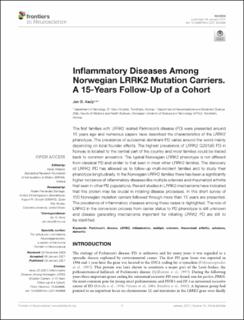| dc.contributor.author | Aasly, Jan | |
| dc.date.accessioned | 2021-04-15T12:12:15Z | |
| dc.date.available | 2021-04-15T12:12:15Z | |
| dc.date.created | 2021-04-06T14:39:16Z | |
| dc.date.issued | 2021 | |
| dc.identifier.citation | Frontiers in Neuroscience. 2021, 15, 1-11. | en_US |
| dc.identifier.issn | 1662-4548 | |
| dc.identifier.uri | https://hdl.handle.net/11250/2737930 | |
| dc.description.abstract | The first families with LRRK2 related Parkinson’s disease (PD) were presented around 15 years ago and numerous papers have described the characteristics of the LRRK2 phenotype. The prevalence of autosomal dominant PD varies around the world mainly depending on local founder effects. The highest prevalence of LRRK2 G2019S PD in Norway is located to the central part of the country and most families could be traced back to common ancestors. The typical Norwegian LRRK2 phenotype is not different from classical PD and similar to that seen in most other LRRK2 families. The discovery of LRRK2 PD has allowed us to follow-up multi-incident families and to study their phenotype longitudinally. In the Norwegian LRRK2 families there has been a significantly higher incidence of inflammatory diseases like multiple sclerosis and rheumatoid arthritis that seen in other PD populations. Recent studies in LRRK2 mechanisms have indicated that this protein may be crucial in initiating disease processes. In this short survey of 100 Norwegian mutation carriers followed through more than 15 years are presented. The prevalence of inflammatory diseases among these cases is highlighted. The role of LRRK2 in the conversion process from carrier status to PD phenotype is still unknown and disease generating mechanisms important for initiating LRRK2 PD are still to be identified. | en_US |
| dc.language.iso | eng | en_US |
| dc.publisher | Frontiers Media | en_US |
| dc.rights | Navngivelse 4.0 Internasjonal | * |
| dc.rights.uri | http://creativecommons.org/licenses/by/4.0/deed.no | * |
| dc.title | Inflammatory diseases among Norwegian LRRK2 mutation carriers. A 15-years follow-up of a cohort | en_US |
| dc.type | Peer reviewed | en_US |
| dc.type | Journal article | en_US |
| dc.description.version | publishedVersion | en_US |
| dc.source.pagenumber | 1-11 | en_US |
| dc.source.volume | 15 | en_US |
| dc.source.journal | Frontiers in Neuroscience | en_US |
| dc.identifier.doi | 10.3389/fnins.2021.634666 | |
| dc.identifier.cristin | 1902443 | |
| dc.description.localcode | Copyright © 2021 Aasly. This is an open-access article distributed under the terms of the Creative Commons Attribution License (CC BY). The use, distribution or reproduction in other forums is permitted, provided the original author(s) and the copyright owner(s) are credited and that the original publication in this journal is cited, in accordance with accepted academic practice. No use, distribution or reproduction is permitted which does not comply with these terms. | en_US |
| dc.source.articlenumber | 634666 | en_US |
| cristin.ispublished | true | |
| cristin.fulltext | original | |
| cristin.qualitycode | 1 | |

